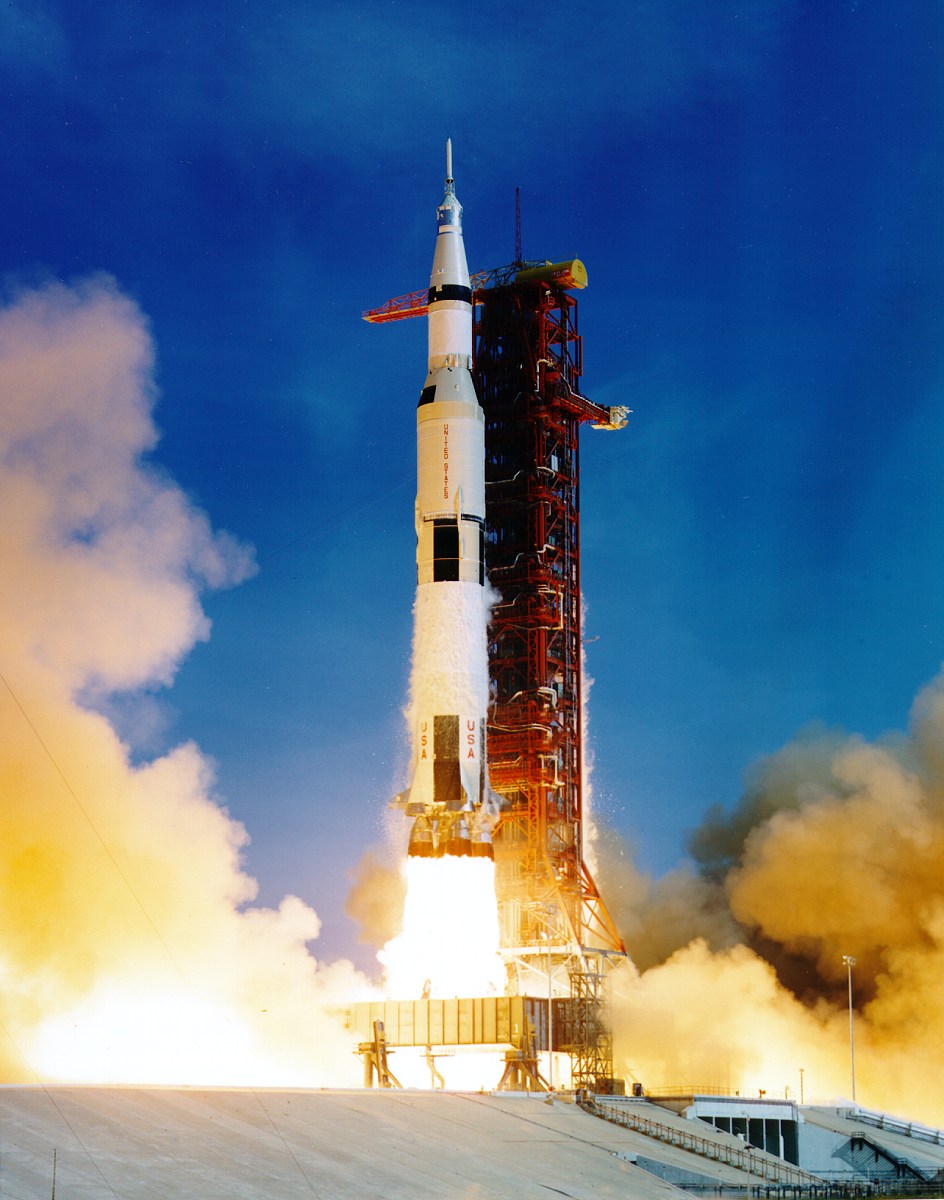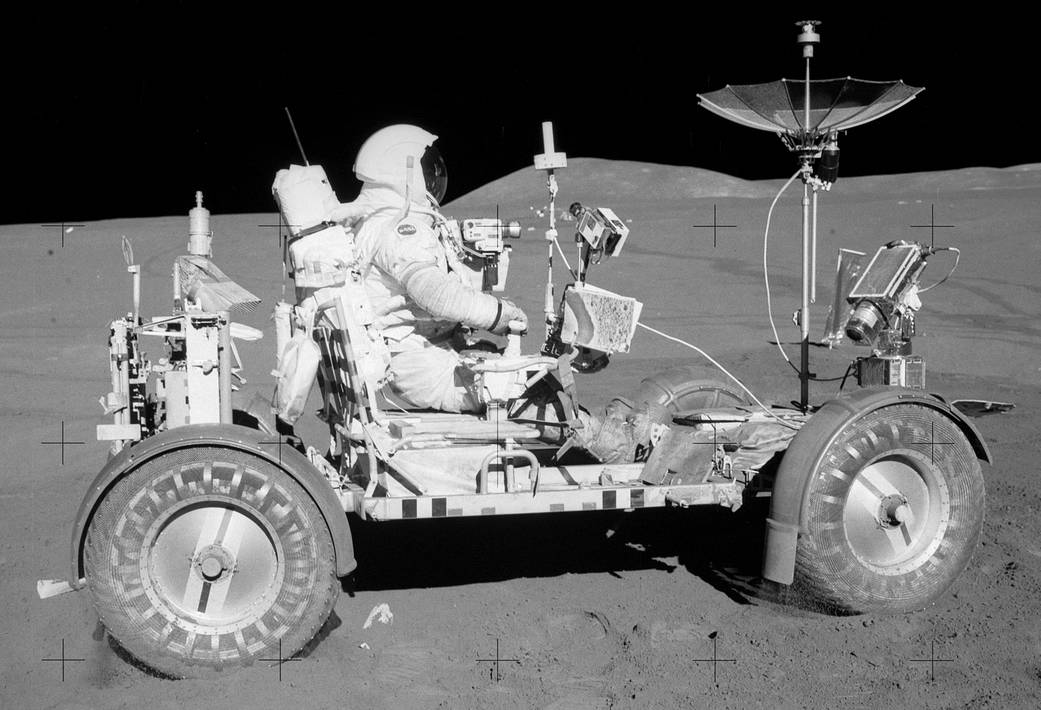
Apollo was the NASA program that resulted in American astronauts’ making a total of 11 spaceflights and walking on the moon.
The first four flights tested the equipment used in the Apollo Program. Six of the other seven flights landed on the moon. The first Apollo flight happened in 1968. The first moon landing took place in 1969. The last moon landing was in 1972.
A total of 12 astronauts walked on the moon. The astronauts conducted scientific research there. They studied the lunar surface. They collected moon rocks to bring back to Earth.

NASA designed the Apollo Command Module for this program. It was a capsule with room for three astronauts. The astronauts rode in the Command Module on the way to the moon and back. It was larger than the spacecraft used in the Mercury and Gemini programs. The astronauts had room to move around inside the spacecraft. The crew area had about as much room as a car.
Another spacecraft, the Lunar Module, was used for landing on the moon. This spacecraft carried astronauts from orbit around the moon to the moon’s surface, then back into orbit. It could carry two astronauts.
Two types of rockets were used for the Apollo program. The first flights used the smaller Saturn I (1) B rocket. It was about as tall as a 22-story building. This rocket had two stages. That means it was made of two parts. When the first part ran out of fuel, it dropped away from the other and burned up in Earth’s atmosphere. The second part continued flying. The Saturn IB rocket was used to test the new Apollo capsule in Earth orbit.
The other flights used the more powerful Saturn V (5) rocket. This three-stage rocket sent the Apollo spacecraft to the moon. It was about as tall as a 36-story building.

The first manned mission to the moon was Apollo 8. It circled around the moon on Christmas Eve in 1968. However, Apollo 8 did not land on the moon. It orbited the moon, then came back to Earth. The crew was Frank Borman, Bill Anders and Jim Lovell.
The first moon landing occurred on July 20, 1969, on the Apollo 11 mission. The crew of Apollo 11 was Neil Armstrong, Michael Collins and Buzz Aldrin. Armstong and Aldrin walked on the lunar surface while Collins remained in orbit around the moon. When Neil Armstrong became the first person to walk on the moon, he said, “That’s one small step for (a) man; one giant leap for mankind.”
The following missions flew humans during Apollo:
Apollo Flight 7
Date: Oct. 11-22, 1968
Mission: Tested the Command Module
Crew: Schirra, Eisele, Cunningham
Apollo Flight 8
Date: Dec. 21-27, 1968
Mission: First to orbit the moon
Crew: Borman, Lovell, Anders
Apollo Flight 9
Date: March 3-13, 1969
Mission: Tested the Lunar Module
Crew: McDivitt, Scott, Schweickart
Apollo Flight 10
Date: May 18-26, 1969
Mission: Tested the Lunar Module around the moon
Crew: Cernan, Young, Stafford
Apollo Flight 11
Date: July 16-24, 1969
Mission: First to land on the moon
Crew: Armstrong, Aldrin, Collins
Apollo Flight 12
Date: Nov. 14-24, 1969
Mission: Landed on the moon
Crew: Conrad, Bean, Gordon
Apollo Flight 13
Date: April 11-17, 1970
Mission: Was supposed to land on the moon but had a malfunction
Crew: Lovell, Swigert, Haise
Apollo Flight 14
Date: Jan. 31-Feb. 9, 1971
Mission: Landed on the moon
Crew: Shepard, Mitchell, Roosa
Apollo Flight 15
Date: July 26-Aug. 7, 1971
Mission: Landed on the moon
Crew: Scott, Irwin, Worden
Apollo Flight 16
Date: April 16-27, 1972
Mission: Landed on the moon
Crew: Young, Duke, Mattingly
Apollo Flight 17
Date: Dec. 7-19, 1972
Mission: Landed on the moon
Crew: Cernan, Schmitt, Evans
Apollo 13 is one of the more famous lunar missions. A movie was made about this flight. Apollo 13 was supposed to land on the moon. On the way there, the spacecraft had a problem. NASA had to figure out how to bring the astronauts home safely. Apollo 13 flew all the way around the moon before returning home. Despite the problem, they were able to land safely on Earth.
The Apollo spacecraft were launched on top of the Saturn V rocket. The Saturn V was made of three stages. The first two stages used up their fuel reaching orbit. The third stage was used to push the Apollo Command Module and Lunar Module to the moon. Once the spacecraft reached the moon, the two modules separated from each other. Two astronauts in the Lunar Module landed on the lunar surface. The third astronaut stayed in the Command Module in orbit around the moon.
On the last three missions, astronauts drove on the moon with the lunar rover. Astronauts drove the lunar rover to explore more of the moon’s surface. The lunar rovers were made so they could be folded to fit in a storage area on the Lunar Module. The lunar rovers were left on the moon.
When the two astronauts were finished working on the surface, they got back in the Lunar Module and launched. It went back into orbit around the moon and connected with the Command Module. The two astronauts got back into the Command Module. They left the Lunar Module behind and flew back to Earth. The Lunar Module crashed into the moon. The Command Module landed in the ocean, and a ship picked up the astronauts.

In 1961, President John F. Kennedy challenged the nation to land astronauts on the moon by the end of the decade. NASA met that challenge with the Apollo program. It was the first time human beings left Earth orbit and visited another world. These missions made it possible to explore more distant worlds further in the future.